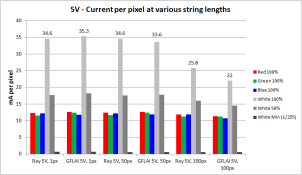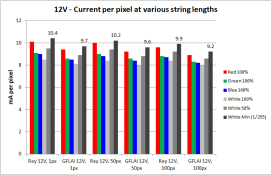thedoctor903
New elf
- Joined
- Jan 11, 2016
- Messages
- 13
Hi All,
Recently I’ve been trying out some of the “seed” style pixels and ended up getting some from both Ray Wu and GFLAI Lighting to compare. I tested both 5V and 12V variants with 5cm spacing and thought I would share my findings in case anyone else is interested. These are the same style of lights that @Mark_M used in his megatree build.
TLDR
I also just discovered that Ray has a heap of new variations on his store. This includes some with spacing from 1.5cm all the way up to 30cm, a 24V version and some with black insulation instead of clear. Bear in mind that replacing a pixel with spacing <5cm may not be easy.
Currently, GFLAI only offer 5cm or 10cm spacing and clear insulation.

To calculate the per pixel current, I divided the total current of the string by the number of pixels.


Power per pixel - 5V vs 12V (mW)

Raw current values
All the values above were derived from the values in the below tables.
5V - Current per string (mA)
12V - Current per string (mA)
Ray’s Pixels
GFLAI Pixels
Voltage was slowly reduced until significant changes occurred.
Both 5V versions reduced brightness until they eventually began going yellow at the end of the string.
The 12V versions basically did not reduce in brightness or colour until the minimum voltage was reached, which was impressive.
Ray’s Pixels
GFLAI Pixels
Recently I’ve been trying out some of the “seed” style pixels and ended up getting some from both Ray Wu and GFLAI Lighting to compare. I tested both 5V and 12V variants with 5cm spacing and thought I would share my findings in case anyone else is interested. These are the same style of lights that @Mark_M used in his megatree build.
TLDR
- The pixels from both vendors look nice and colour mix well.
- They are cheap, compact and lightweight.
- Wire is thin and insulation isn’t great to work with, but it works.
- The 12V version from both Ray and GFLAI appear to operate similar to GS8208 pixels, which makes them quite efficient.
Purchase Details
These lights seem to go by a few names seed/pebble/soft mini pixels depending on the vendor, so that’s something to be aware of.| Pixel Type | Purchased via | Purchase Date | Date Shipped | Date of Arrival |
| Ray 5V – 5cm | Aliexpress | 19/2/2023 | 21/2/2023 | 6/3/2023 |
| Ray 12V – 5cm | Aliexpress | |||
| GFLAI 5V – 5cm | Email (see this thread for details) | 1/4/2023 | 15/4/2023 | 24/4/2023 |
| GFLAI 12V – 5cm | Email (see this thread for details) |
I also just discovered that Ray has a heap of new variations on his store. This includes some with spacing from 1.5cm all the way up to 30cm, a 24V version and some with black insulation instead of clear. Bear in mind that replacing a pixel with spacing <5cm may not be easy.
Currently, GFLAI only offer 5cm or 10cm spacing and clear insulation.
Physical comparison
- All appear well sealed and the coating over the pixel feels very durable.
- The size of lights varies a little bit, GFLAI’s 5V pixels are definitely the slimmest. See the below pic for comparison.
- Wire is very thin on all. GFLAI says their copper wire is 12dmm or 0.12mm, unsure about Ray’s. Based on my current and voltage drop tests, I believe GFLAI’s wire may be slightly thinner than Ray's.
- Insulation is the same on all, and it’s not great in my opinion. It’s difficult to cleanly separate wires (a blade seems to work best) but it does its job. Unsure how the insulation will hold up to the weather.
- All are similar brightness and have good colour as far as I can tell. The whites are also good, although Ray’s 5V had a tinge more green than the others.
- Ray’s 5V and 12V have a strand of untinned copper wire amongst the other tinned copper(?) strands, this indicates the positive wire.
- GFLAI has the same on their 5V version, but not on their 12V, which is annoying.
I have emailed them to see if there is an easy way to identify the positive, but have not heard back yet.
I did hear back from GFLAI, and it doesn't seem like there is a simple way to identify the wires on the 12V pixels. I suggest marking the data-in end or the positive wire when cutting strings to length. It's not ideal, but the only other suggestion GFLAI had is to cut one pixel off and try powering it, I assume with a 50/50 chance of killing the pixel. - All wires tinned fine.
- All seem to get a little bit warm in operation.
- None of them had a built-in test pattern based on my testing.
- Colour order: Ray 5v GRB, Ray 12V RGB, GFLAI 5V BGR, GFLAI 12V RGB

Power Measurements
Test setup- Gamma correction was off.
- The voltage source was adjusted so that there was always 5.0/12.0V at the start of the pixel string before current was measured.
- Power was only injected from one end (data in).
- Pixel data provided by an ESPixelStick V2.
- Strings of 1, 50 and 100 pixels were tested for each type.
- I used the pre-soldered pigtail on Ray’s 12V string, the others were bare wire.
To calculate the per pixel current, I divided the total current of the string by the number of pixels.
- The 5V pixels reach their highest current at full white, as you would expect.
- The 12V pixels from both vendors appear to operate similar to the GS8208 pixels I’ve read about.
Full white actually draws the least current, and dimmed colours draw more. - Based on the specs GFLAI told me, I was expecting around 20mA for both 5V and 12V versions. I was quite surprised the 5V pixels use significantly more (even in a string of 50), and the 12V ones use significantly less.


Power per pixel - 5V vs 12V (mW)

Raw current values
All the values above were derived from the values in the below tables.
5V - Current per string (mA)
| Ray 5V, 1px | GFLAI 5V, 1px | Ray 5V, 50px | GFLAI 5V, 50px | Ray 5V, 100px | GFLAI 5V, 100px | |
|---|---|---|---|---|---|---|
| Red 100% | 12.3 | 12.6 | 620 | 630 | 1190 | 1130 |
| Green 100% | 11.5 | 12.4 | 580 | 620 | 1120 | 1120 |
| Blue 100% | 12.13 | 11.7 | 610 | 590 | 1180 | 1070 |
| White 100% | 34.6 | 35.3 | 1730 | 1680 | 2580 | 2200 |
| White 50% | 17.7 | 18.2 | 880 | 890 | 1600 | 1450 |
| White Min (1/255) | 0.6 | 0.6 | 29 | 29 | 55 | 57 |
| Off/Black | 0.55 | 0.55 | 26 | 26 | 50 | 52 |
12V - Current per string (mA)
| Ray 12V, 1px | GFLAI 12V, 1px | Ray 12V, 50px | GFLAI 12V, 50px | Ray 12V, 100px | GFLAI 12V, 100px | |
|---|---|---|---|---|---|---|
| Red 100% | 10.1 | 9.4 | 500 | 460 | 960 | 890 |
| Green 100% | 9.1 | 8.6 | 450 | 430 | 880 | 830 |
| Blue 100% | 9 | 8.5 | 440 | 420 | 870 | 820 |
| White 100% | 8.5 | 8.1 | 420 | 400 | 840 | 800 |
| White 50% | 9.5 | 8.9 | 470 | 440 | 920 | 860 |
| White Min (1/255) | 10.4 | 9.7 | 510 | 480 | 990 | 920 |
| Off/Black | 0.62 | 0.6 | 27 | 27 | 55 | 51 |
Voltage at end of string
Same setup as above.Ray’s Pixels
| 5v, 50px | 5v, 100px | 12v, 50px | 12v, 100px | |
|---|---|---|---|---|
| White 100% | 4.24V | 3.06V | 11.8V | 11.23V |
| White 50% | 4.62V | 3.69V | 11.77V | 11.15V |
GFLAI Pixels
| 5v, 50px | 5v, 100px | 12v, 50px | 12v, 100px | |
|---|---|---|---|---|
| White 100% | 3.95V | 2.81V | 11.76V | 11.08V |
| White 50% | 4.44V | 3.35V | 11.74V | 11.0V |
Min voltage at start of string before discoloration/reduced brightness at end
This is a very subjective test, so YMMV. Same setup as above (powered from one end only).Voltage was slowly reduced until significant changes occurred.
Both 5V versions reduced brightness until they eventually began going yellow at the end of the string.
The 12V versions basically did not reduce in brightness or colour until the minimum voltage was reached, which was impressive.
Ray’s Pixels
| 5v, 50px | 5v, 100px | 12v, 50px | 12v, 100px | |
| White 100% | 3.6-3.9V | 4.4-4.7V | 8.2V | 8.7V |
| White 50% | 3.5-3.8V | 4.0-4.3V | 8.1V | 8.7V |
| White 25% | 3.4-3.7V | 3.9V | 8.1V | 8.7V |
GFLAI Pixels
| 5v, 50px | 5v, 100px | 12v, 50px | 12v, 100px | |
| White 100% | 3.8-4.2V | 5.0V – discoloured slightly at end already. | 7.9-8.0V | 8.4V |
| White 50% | 3.7-3.9V | 4.0V | 7.9-8.0V | 8.4V |
| White 25% | 3.6-3.8V | 3.7-3.9V | 7.9-8.0V | 8.5V |
Mixing pixel types
Lastly, I tested chaining the seed pixels data output to some 5V bullet pixels I had, and it seemed to work fine. I also tried the reverse (bullets -> seed) and that also worked fine for all. Mixing 5V -> 12V seed pixel data and vice versa also worked.
Last edited:

